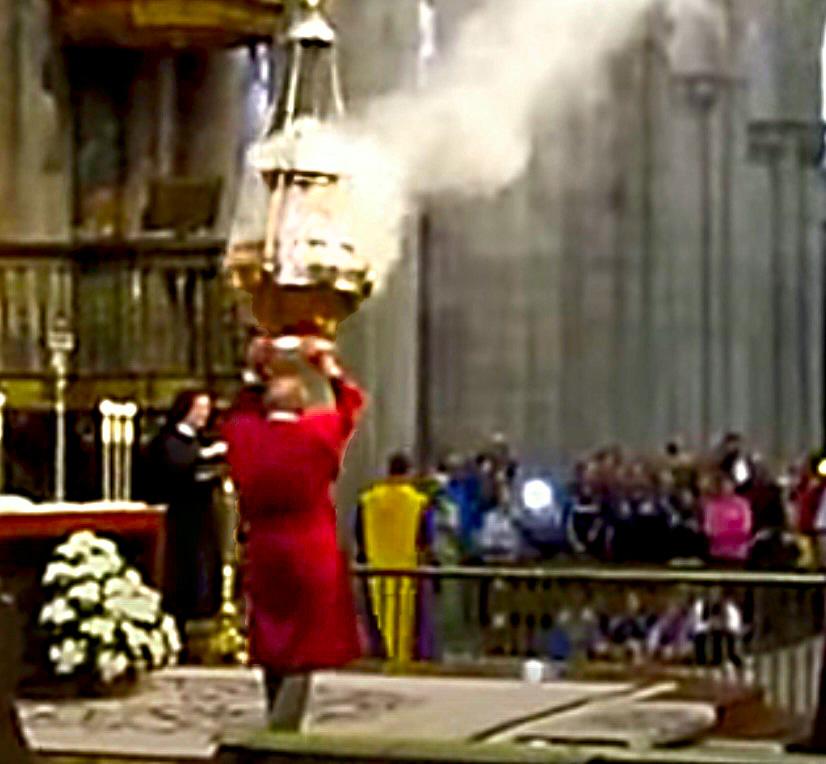13. Ritual
If we regularly repeat some action in order to give ourselves comfort, and if it’s not something that requires psychiactric intervention, we might describe our activities as a ritual of some kind.
Every summer Sunday morning, when I was young, I would wake up in my cabin and soon head over to the Interlochen Main Camp — a pleasant half-mile walk through a pine forest. As I walked I was serenaded by a distant brass choir playing the almost bouncy music of Giovanni Gabrielli (search for Canzon septimi toni no. 2). As I would get closer, the music would became clearer and louder, almost as if a bunch of hefty angels were approaching. This was our Sunday morning call to worship, and offered a musical separation from the rest of our other days, where much of the music we made was merely an approach to the divine. For me, in those days, a brass choir playing Gabrielli in the clear morning air, got all the way there.


On road trips today, I find that I can often get off to a good musical start with Gabrielli, played by a brass choir. This is music of joy and optimism and never gets old.
I’m not terribly religious, but I sang in our temple’s children’s choir. I did it for fun, and I was trying to help out. But I spent more time in church, since I was studying the pipe organ, and the music was better. Sad to say, there is no Jewish Bach. At least not yet.
In religious ceremonies, music often plays a central part of worship. We listen, we meditate, and sometimes we all sing together. Music serves ritual.
Music can also be ritual. Singing Happy Birthday is a ritual for birthdays. The Swedes, I discovered with some good friends at their house in Stockholm, have delightful ritual songs to toast an after-dinner aquavit. Even the children know them. Now when we celebrate some occasion with pickled herring and aquavit we do it without the songs and a little something from that ritual is missing.
You may have observed that your dogs appreciate, and even need, ritual. Maybe it’s the way they might sit when you’re about to put their bowl down. Maybe it’s that best behavior moment when they wait at the door, the moment before you open it and they can bolt. Tesla had ritual behaviors for every possible occasion. She might be running in a public park like a lunatic, and then at the appearance of even the lowliest pigeon, she suddenly froze, one paw drawn up, her entire body quivering with excitement as she pointed, and then, catlike, stalked. As soon as the pigeon took flight, Tesla instantly switched back to being an out-of-control maniac. She never failed to draw a crowd with the startling clash of these two ritualized behaviors.
In our house, now consisting of only Leanne and myself (still haven’t been able to commit to a new animal), we have a Sunday ritual. I’m not suggesting you follow it, since it may not be to your taste. I’m simply offering this as an example of what your family might want to do on whatever day of the week is your most peaceful.
This ritual began with my desire to get more familiar with all of Bach’s cantatas, the musical interludes he wrote for Sunday morning services, mostly in Leipzig for his employer, the Thomaskirche. Bach’s job description called for him to be the church organist, to train and rehearse the choir, and to compose a concert of new music every week. Two hundred of Bach’s sacred cantatas survive, and there are also some sixteen secular ones. The cantatas generally last around 20 minutes each.
Bach’s studies were deeply marinated in the Lutheran liturgy, and as cantor and composer, Bach often developed his cantatas to function as multi-part sermons, often in the form of miniature dramas. Some begin with a symphonic-like overture or Sinfonia or a piece for the choir, and then an aria for a soloist, possibly then a duet between two singers, then a chorus, continuing the rotation of forces to create variety and keep the congregation awake and emotionally engaged.
Bach wrote each cantata for some specific Sunday in the Lutheran liturgical year. It would be nice if I could plan the entire year around these, but that’s way too rigid for us — and there are many weeks when we’re just not home to listen to a batch of cantatas. So instead we just take them by number, cycling through from BWV 1 all the way to BWV 220, and then we start over again. We listen to two or three on any given Sunday and it takes us a year and a half to two years to go through the entire cycle. And then after a few weeks break, we miss them and start all over again.

The cantatas each have a German name which is taken from the first sung lyrics of the cantata. My German is limited to Ach and Ich, as well as mensch and hertz and the ever-lovely Morgenstern — morning star. Some of the names are memorable even if your German is similar to mine. Take, for instance. BWV 12 Weinen, Klagen, Sorgen, Zagen. Many call out to God in their first lines, so we have Ach Gott in BWV 2 and 3, Liebster Gott, Lobet Gott, Wär Gott, Herr Gott, Gottlob and many dozens more. In the BWV 201 to 220 range, the secular cantatas, the naming is much more accessible, with a Hunting Cantata, Peasant, and the delightful and much-recorded Coffee Cantata, BWV 211.
Bach’s cantatas are, of course, perfect for Sunday mornings because that’s what they were intended for. Church-going in Bach’s time was somewhat less formal than now, and it appears that people customarily would often arrive late at a service, and leave when they wanted. So Leanne and I have little guilt talking once in a while over the music when we want to note to each other something of interest from the newspaper. Like our lox and bagels and orange juice, the cantatas are simply part of the ritual of Sunday morning. Something that separates it from the rest of the week, makes it special.
I have been collecting and organizing the 4 terabyte drive that holds our music, and the largest section devoted to any one group of pieces is dedicated to the Bach cantatas. We have at least four and as many as ten performances of each cantata, so easily more than a thousand performances in total.
If you want some thoughts on where to begin, first of all, I hope you’ll discover that there is something gorgeous in every cantata. Some moments are drop dead, put-down-your-fork amazing, and many offer beautiful arias, or songs, for every kind of voice color. Here are a few contatas to try, just to encourage you to put your toe in the water: BWV 18 has a first movement, a Sinfonia, that feels like an autumn leaf that’s about to let go, and then suddenly it lets go and rocks back and forth as it settles to the ground. Truly infectious, and if you can a recording by Jeffrey Thomas conducting the American Bach Soloists, you will have a good start.
If you want to find one with a melody you probably already know, then try BWV 140, known as ‘Wachet auf.’ If you can find the recording by Hans-Joachim Rotzsch, listen to that, since he had Bach’s old job at the Leipzig Thomaskirche and the kids and adults in the choir are direct musical descendant’s of Bach’s choir, singing in the same space, maybe even sitting on the same chairs when Bach had them under his gaze. (Hopefully the robes have been changed every century or so.)
For other performances of the contatas there are a lot of riches to choose from. Many of these are in complete sets, other ensembles have just recorded their favorites. Philippe Herreweghe and his regular ensemble, the Collegium Vocale Gent brings a precision to them that is always clean and revealing.
In the year 2000, on the 250th anniversay of Bach’s death, John Eliot Gardiner created a Pilgrimage to perform all 200 sacred cantatas in the course of a single year, travelling to sacred spaces all around Europe, and gathering Pilgrimage followers into an ever-larger travelling audience. The resulting recordings are consistently lively and fresh as each week the performers needed to discover and rehearse all new cantatas one after the other. It was the one of the greatest Bach celebrations of all time and touched the lives of all the performers and many of the audiences. Medici.tv, a paid subscription service, has an hour-long documentary about the Gardiner Bach pilgrimage which conveys the passion that was required to complete this astounding journey.
Masaaki Suzuki and his ensemble devoted to Bach in Japan, the Bach Collegium, has recorded all the cantatas underpinned by Suzuki’s high level of scholarship and consistent selection of lovely soloists. The first set of complete recordings which attempted to replicate the instruments of Bach’s own time were done by Nikolaus Harnancourt and Gustav Leonhardt. Although these recording go back to the 1970s, the sound is wonderful and the performances are bursting with color and variety. I also like many of the recordings by Karl Richter and Helmuth Rilling.
While listening to one of the Cantatas and you suddenly hear something that is out of the ordinary magnificence, you can always interrupt your normal reading and hop over to bach-cantatas.com which has endless resources for deep information and critical reaction to each cantata, including the German text and translations into dozens of languages, plus more scholarly commentary than anyone could possibly absorb. Nevertheless, worth surfing.
If you find a way to bring music into your life, and the life of your home, in a regular, even formal way, you just might have found a path to a little more peace or tranquility than you otherwise would not have found. It doesn’t have to be Bach cantatas, but I think it will help if you can find a certain kind of music that you can enjoy while you’re starting your special day of the week, and that the body of work can get you through a great many days without having to plan what’s coming next. You might find it in classical guitar, in organ works of Bach or Buxtehude, or even in the symphonies of Joseph Haydn (there are more than one hundred.) I hope you’ll try BWVs 18 and 140 to see whether they have something to say to you.
